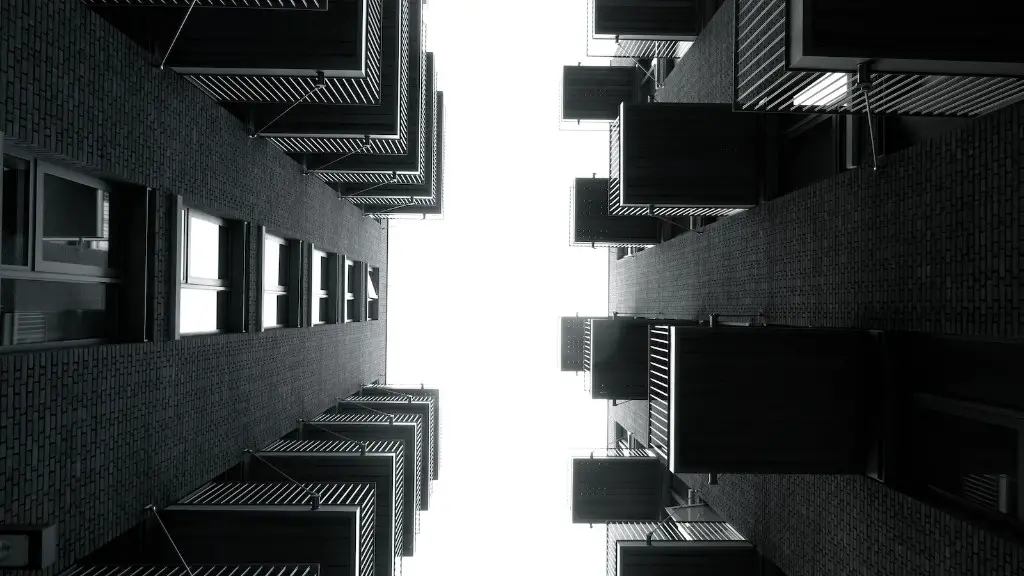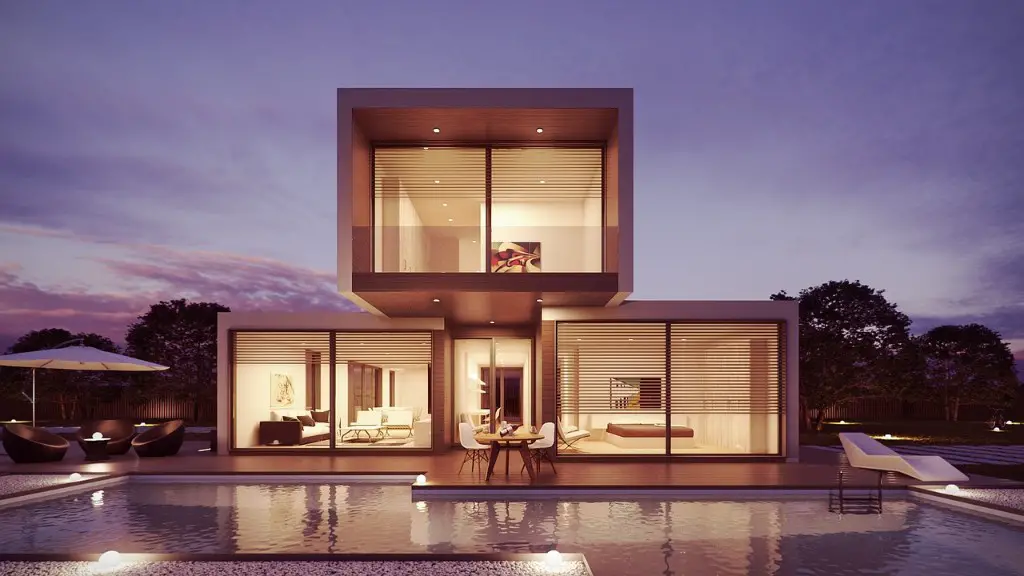Traditional Nigerian architecture is a exhibition of beautiful artistic creation that holds many cultural values. It is uniquely created through the combination of materials, forms, uses, and aesthetic standards that are appreciated even by the uninitiated. In comparison to other African countries, Nigeria has a very diverse architectural style, with a wide array of inspiration from both the local community and foreign cultures.
The use of locally sourced materials is essential in traditional Nigerian architecture. Mud, clay and stones are some of the traditional materials used in these buildings. Such materials are usually combined with wood and iron to form walls, roofs and openings. Traditional mud houses are often characterized by the ingenious use of gables, sloping walls and decorative designs.
The cultural identity of Nigerian architecture is also illustrated in terms of the shapes and design of buildings.Traditional structures typically feature geometric shapes, graceful curves and various elemental forms. Traditional homes, for instance, are typically round or cone-shaped structures, generally with inward sloping sides and stone foundations. On the other hand, traditional mosques, churches and palaces take on an imposing and grand appearance with towering spires and imposing entrance gates.
A great deal of exploration into traditional Nigerian architecture has also revealed its intimate and dialectical relationship with its natural environment. Whilst the traditional use of vernacular materials and forms has allowed for a harmonious relationship with Nigeria’s natural landscape, the use of water and air circulation has allowed for cooler temperatures and better air quality, thus creating a more conducive environment.
In terms of architectural and design principles, traditional Nigerian architecture often relies on concepts of balance, symmetry, proportion and scale. Such principles have been developed over the centuries to create a functional yet aesthetically-pleasing environment. Such principles need to be taken into consideration during the re-design process to ensure continuity with the traditional built form.
Today, many traditional Nigerian architectural styles are being modernised in order to better suit the needs of contemporary society. Such modifications have been made while attempting to preserve the traditional materials, forms and uses of the style. One such example is the contemporary adaptation of traditional mud-fashioned buildings, which are now made with concrete and steel to better withstand the rigours of modern life.
Traditional Nigerian architecture has survived centuries of political and cultural turmoil, and today stands as a testament to the rich heritage of this nation. It remains a source of inspiration and pride for many Nigerians, and its influence can still be seen in the built environment of today.
Economic Impacts
The economic implications of traditional Nigerian architecture have been immense, particularly in terms of its role in sustaining local economies. Building with traditional materials and forms has long been an important source of income for construction workers and artisans, who contribute to the overall economic prosperity of their communities.
In terms of job creation, the use of traditional materials and forms has created a demand for skilled labor, ranging from masons to carpenters and artisans. All these workers come together to create traditional buildings, thus creating a vibrant economy around the production of such buildings.
The traditional style of architecture also provides long-term economic gains. The use of traditional building techniques has allowed for greater durability than more contemporary methods, thus reducing the costs of maintenance and repair. This is not only beneficial to property owners but also to the wider economy, in terms of the savings generated.
The traditional style of architecture has also been integral in terms of tourism. The distinctive forms and designs of traditional architecture are a major source of attraction for many tourists and provide a much-needed source of income for many communities.
Cultural Significance
Traditional Nigerian architecture has contributed to the national culture of this country in many ways. It has been used as a means of expression and communication by its inhabitants, conveying messages of spirituality and identity. It is also important in terms of cultural preservation, with traditional buildings serving as symbols of pride and ancestry.
Traditional architecture in Nigeria is also an important contributor to the intangible heritage of this nation. It is a representation of the values, beliefs and customs of its people, and as such is an important tool in preserving the nation’s cultural identity.
In terms of documentation, traditional Nigerian architecture has been widely documented and studied by academics, architects and historians. This allows for a greater understanding of the nuances of traditional architecture and cultural values, thus promoting their preservation and appreciation.
Traditional Nigerian architecture is an invaluable asset to the nation and its people and should be made available to the public for appreciation and recognition. This allows for the ongoing protection of this unique art form and the preservation of its invaluable cultural values.
Modern Impacts
The introduction of modern building techniques has had both positive and negative impacts on traditional Nigerian architecture. On the one hand, the use of new materials and methods has allowed for a greater level of creativity and expression in the built environment, thus creating a more diverse and interesting landscape.
On the other hand, the use of new materials and methods has threatened the viability of traditional building techniques, with many such methods now being obsolete. This has eroding the authenticity of traditional architecture and its unique qualities, thus damaging its cultural value.
In order to maintain the viability and cultural significance of traditional Nigerian architecture, it is important for architects and planners to strive for a balance between traditional and modern techniques. This can be achieved by incorporating vernacular designs and principles into modern building projects, as well as making use of traditional building materials.
Additionally, it is important to ensure that traditional buildings are preserved and protected. The use of legal instruments such as heritage zoning, zoning ordinances and preservation laws can all help to protect traditional buildings, ensuring that they remain a part of the nation’s cultural and historical heritage.
Global Influence
The influence of traditional Nigerian architecture has extended far beyond the borders of Nigeria. Nations around the globe have adopted some of its features, creating a variety of charming and interesting architectural styles.
In the United States, for example, there has been a strong influence of Nigerian-style architecture on the design of private homes and public buildings. From religious structures and city halls to private homes, the influence of Nigerian architecture can be seen everywhere.
In the United Kingdom, Nigerian styles have also made their mark on the built environment, particularly in the cities of London and Manchester. The influence of Nigerian culture and architecture can be seen in the many majestic buildings and beautiful parks around the cities.
The influence of Nigerian architecture can also be seen in the wider world. Examples include the use of traditional Nigerian motifs in the architecture of many African countries and the incorporation of Nigerian features into modern architectural styles such as Brutalism.
Educational Impact
Traditional Nigerian architecture has also had a considerable impact on the nation’s education system. Its principles and building techniques have been incorporated into the nation’s formal curriculum, thus paving the way for a greater appreciation of this unique art form.
In addition to teaching students about the history and principles of traditional Nigerian architecture, educational institutions have also encouraged students to engage in the practice of traditional building techniques. These include the use of mud and clay as building materials and the creation of intricate carvings and motifs.
Furthermore, educational institutions have also facilitated the hosting of exhibitions and talks, allowing members of the public to explore traditional Nigerian architecture and its significance to Nigerian society. Such events provide the opportunity to interact with artisans and share their experiences.
In conclusion, traditional Nigerian architecture is an integral part of the nation’s cultural heritage and identity. Its influence is not only seen in the built environment, but also in the educational system, with its principles and building techniques inspiring generations of young Nigerians.





